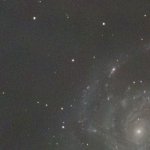I followed the tutorial at https://www.lightvortexastronomy.co...rating-and-stacking-images-in-pixinsight.html to stack 63, 180s subs of M101. After all is done, I get a blotchy color background as shown in the attachment. I didn't succeed in using noise reduction techniques (e.g., multiscale linear noise reduction) to get rid of this: it just turns into a diffuse elevated background, mostly.
I'm unsure of the source of this noise or what can be done about it. Is it just light pollultion and moonlight? Any advice would be appreciated.
Imaging conditions: Bortle 8 (Chicago suburbs), full moon, Optolong L-Pro filter, 8" Meade LX90, ASI071MC Pro at -25 C, CEM40EC mount, off-axis guider with ASI290MM mini. As stated, the subs were 180s each and I stacked 63 of them.
Thanks--Michael
I'm unsure of the source of this noise or what can be done about it. Is it just light pollultion and moonlight? Any advice would be appreciated.
Imaging conditions: Bortle 8 (Chicago suburbs), full moon, Optolong L-Pro filter, 8" Meade LX90, ASI071MC Pro at -25 C, CEM40EC mount, off-axis guider with ASI290MM mini. As stated, the subs were 180s each and I stacked 63 of them.
Thanks--Michael

